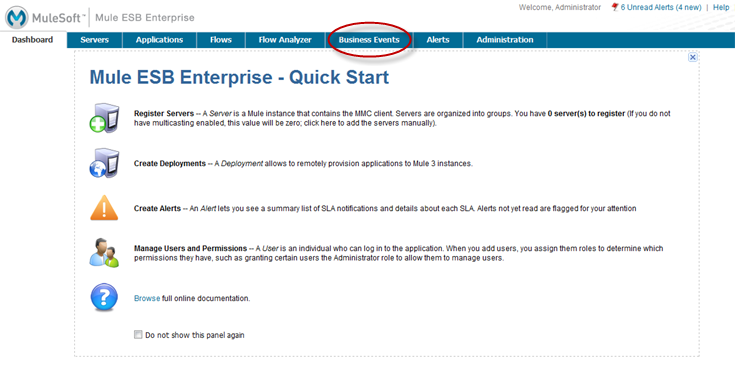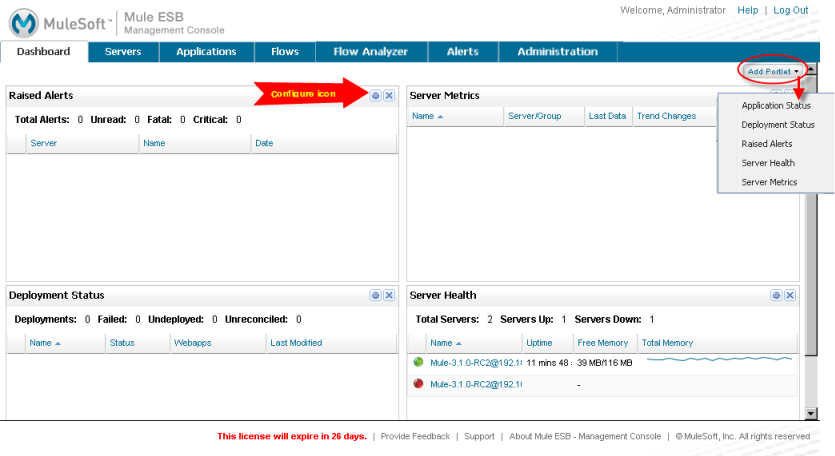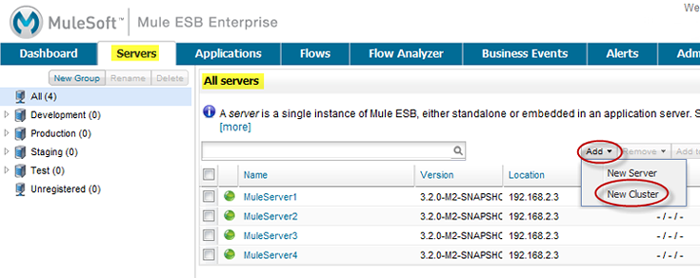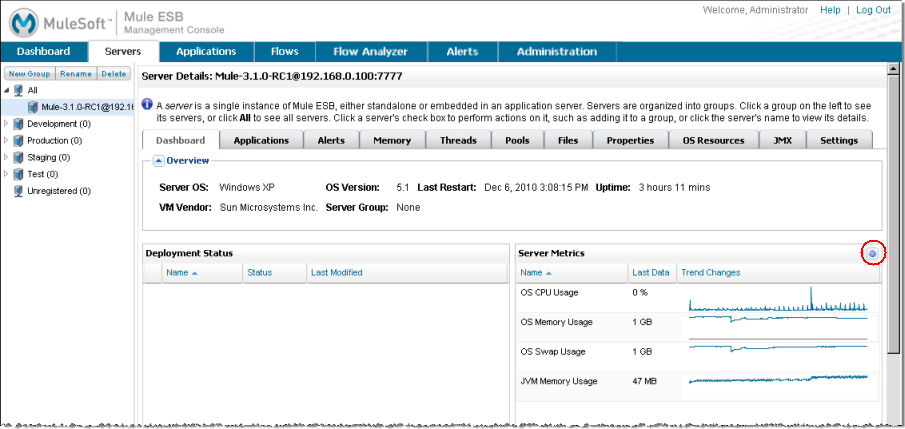
How to Use the Management Console
The management console provides singular visibility into the Mule ESB runtime environment, deployed flows, and the messages processed by the enterprise service bus.
From a single console you can manage and access all of your instances across the enterprise (including those potentially running outside the firewall). You can track the metrics and events deemed critical to running your business. As part of that tracking, you can have the console trigger alerts proactively when events and metrics begin to change.
You can also manage, access, and track metrics and events for clusters, where a cluster is a set of Mule instances that acts as a unit. In other words, a cluster is a virtual server composed of multiple nodes.
When messages get stuck, errors occur, or SLAs are trending in the wrong direction, the console gives you the tools to perform deep introspection and auditing of what is happening in the bus.
You can manage the deployment of Mule applications (flows) right from the console, giving you complete control and governance over the life cycle of your flows. Above all, to ensure security, communication is encrypted and access is controlled by enterprise authentication and fine-grained, role-based access control.
If you have downloaded the evaluation version of Mule ESB Enterprise, you have everything you need to get started. Fire up Mule and enter http://localhost:8585/mmc in your browser to log in. The default login is admin and the default password is also admin.
Quick Start Dashboard
When you first start the console and log in, you are presented with the Quick Start dashboard, giving you immediate access to the common tasks you might wish to perform:

From the dashboard, you can click the tabs to go to the screens through which you manage your Mule servers and deploy applications, along with monitoring and managing flows, alerts, audits, and administrative tasks.
The Business Events tab gives you visibility into business transactions and events on your Mule servers. You can use this tab to find out what happened to particular messages.

The icons on the left side provide quick links to screens for registering servers, deploying applications, creating alerts, and managing users and permissions. If you hover your mouse over the individual tabs pop-up tips display.
Keep in mind that if you have just installed a Mule ESB server, the server must be registered with the console and you may need to connect the console to that server before using any of the other console features.
| If you are using the Mule ESB Enterprise evaluation, the console is running embedded in the Mule Server and is already connected and monitoring the local instance. |
Connecting the console to a server entails registering the server with the console. To register servers, click the icon to the left of Register Servers or the Servers tab at the top.
Dashboard Data Panels
Click the X at the top right of the Quick Start screen, or check the "don’t show this panel again" box at the bottom of the screen, to see the dashboard itself. (See the figure below.)

Each data panel in the dashboard (Server Health, Raised Alerts, Application Status, Deployment Status, and Server Metrics) is considered to be a portlet. A portlet is a customized view of information about your servers or applications. To display a particular portlet, click the Add Portlet button and click those portlets you want displayed. Click the X icon in the title bar of a portlet you want removed from the dashboard. For more information on customizing the dashboard, see Customizing the Dashboard.
In addition, there are two cluster-related portlets in the dashboard (Cluster Status and Cluster Application Status).

Using the Console
Use the tabs across the top of the console to view and manage your servers, applications, and flows, along with other administrative tasks.
Here’s a quick tour of the things you can do with the console:
-
View Servers - See what servers are registered and the applications running on these servers. The console lets you browse server resource metrics and displays a set of information about each server.
-
View Clusters - See what clusters have been created, what nodes are in a cluster, and what applications have been deployed to a cluster. The console lets you browse resource metrics for a cluster and displays a set of information about each node in the cluster.
-
Deploy Applications - Select a local application on your platform and deploy it to an available server. You can also deploy an application to a cluster.
-
View Applications - See the deployed application and verify that it is running correctly.
-
View Flows - For a deployed application, see the flows that are part of the application. As more applications are deployed, you can filter the display so it only shows flows by specified applications. You can keep an eye on events as they are processed, track event processing metrics, and see how events are impacted.
-
Alerting - Set up alerts to monitor the application according to metrics of interest to you.
-
Trigger Events and See Alerts - Track and generate application errors, stop and restart flows, get notified when a server or server group goes down or comes back up, and so forth.
-
Get notified when a node in a cluster goes down or comes back up.
-
Analyze business events - View information recorded for the flows and message processors handling your business transactions. You can query information such as processing time, errors, and so forth. You can even set up custom events for tracking.
-
Flow Analysis and Auditing - Turn auditing on for a flow, then see what message processing is taking place. In addition, you can inspect the contents of the messages.
-
Manage Server Resources - View memory utilization and thread processing. Adjust thread pools.
-
Perform Administrative Tasks - Manage users and roles, along with their access permissions. Create scripts and automate tasks.
If you are in Operations, you might be particularly interested in these console tabs and screens, depending on the tasks you need to perform:
-
To manage the application repository and deployments, use the Applications tab.
-
To monitor a server, such as to check if the server is up or down, see how much memory the server is using, or generally keep an eye on the server profile, use the Servers and Alerts tabs. Also use the Servers and Alerts tabs to monitor a cluster.
-
To check on performance bottlenecks so that you can alert developers, look at the Flows tab as well as the
Flow Analyzer tab.
If you are a developer, you might find these tabs and screens of most use to you:
-
To diagnose problems, such as memory and performance bottlenecks, use the Flows and Flow Analyzer tabs. The Flow Analyzer tab is particularly helpful because it lets you audit a flow so that you can debug the flow performance and verify payload content along with message properties.
-
If you need to manage deployments or the application repository, use the Applications tab.
-
If you need to create scripts to automate tasks, use the Administration tab.
System administrators will find the Administration tab most useful. They can use these screens to manage users and roles, handle licensing issues, and schedule automated tasks.
Layout of the Console
The console screen layout is essentially the same regardless of the tab you click. Notice that the management console screen is divided into two sections:
-
A context-sensitive navigation pane on the left
-
A details pane on the right that also reflects the particular tab you have selected
Both the navigation pane and the details pane sections include appropriate sets of buttons that you click to perform specific tasks.
For example, the figure below shows how the console screen Servers pane might look when you first log in. When you select the Servers tab, the navigation pane displays the organization or grouping of the servers, while the details pane shows summary information in columnar form about each server instance. Notice that when you hover the mouse over a column, a pull-down menu icon appears and you can sort by that column’s data, plus select columns to display or hide. The function buttons for the navigation pane let you add a new server group, rename a group, or delete a group. Similarly, the buttons available for the details pane provide functions for operating on individual servers. Notice that these buttons, except for New Server, are grayed out. When you select a particular server, by clicking the box to the left of that server, the buttons become operational and you can click the function you want to apply, such as adding the server to a group.

Use the Add button in the details pane to add a new server or a new cluster. Use the Remove button to unregister a server or disband a cluster and return its nodes to the pool of standalone instances.

Using the Navigation Pane
You use the navigation pane on the left side of the console screen to get a quick, high-level view of the organization of your servers, flows, and users. The pane displays information matched to the selected tab. For example, when the Servers tab is selected, it displays all server groups that have been set up and lets you expand each group, by clicking the arrow to the left of the group name, to see any servers within that group.
Understanding the Console Tabs
The tabs across the top of the console screen – Servers, Applications, Flows, Flow Analyzer, Alerts, and Administration – let you easily view and manage servers, deploy and manage applications, manage flows, analyze and audit the system processing, manage alerts; and manage users and perform other administrative tasks.
The Business Events tab gives you visibility into business transactions and events on your Mule servers.
Servers Tab
Click the Servers tab to add and remove Mule ESB server instances, register servers, create your own groups to organize servers, add servers to one or more groups, start or stop servers, or move them between groups.
You can also use the Servers tab to create a new cluster, add nodes to a cluster, or disband a cluster.
Use the Servers details pane to get detailed information about individual servers beyond the summary information. To get detailed information about a particular server, click the server name in the details pane table. You should see information about the server. The figure below shows the summary details about a selected server.
Click any of the tabs in the details pane to view more specific information about the selected server, such as the applications deployed on that server, any alerts that have occurred, memory usage, plus information about threads, pools, files, server properties, OS resources, JMX, and settings for the server.

The display is customizable. You need only click the configure icon (circled above) to customize the metrics display portion of the servers details pane.
See Monitoring a Server for more details on using the server screens.
Applications Tab
Use the Applications tab to view and manage applications deployed to the server.
You can also use the Applications tab to view and manage applications deployed to a cluster.
From this tab, you can deploy, redeploy, and undeploy applications. You can also maintain the applications stored in the repository.
See Deploying Applications for details on deployments.
See Maintaining the Server Application Repository for more information on the repository.
Flows Tab
Flows represent the different components or message processors – including transformers, controllers, routers, filters, the main application class or web component, along with the message source or endpoint itself – for processing an application’s message. Similar to the Servers tab, you click the Flows tab to get information about and to manage specific flows.
The figure below shows a typical display for all flows, which appears when you click the Flows tab.

Flow Analyzer Tab
Use the Flow Analyzer tab to see any auditing information that the console has captured for you. You need to first enable auditing, which you do from the Flows tab. When auditing is enabled, you see a message on the Flows pane that indicates the system is capturing audit data.
The Flow Analyzer pane displays audit information organized by server, applications, and flows. You can analyze flow processing using the detailed message payload content and message processor data available from this pane. The figure below is an example of the Flow Analyzer pane.

See Working with Flows for more details on auditing and analyzing flows.
| Flow analysis is not available for clusters. It is primarily a development-time tool. However, you can use it on a standalone server running an application that you plan to deploy to a cluster. |
Business Events Tab
Use the Business Events tab to retrieve information, such as processing time and errors, for business transactions and events on your Mule servers. You can set up queries to select and view subsets of business transactions handled by your servers. You specify various criteria for selecting transactions, search for particular values, and apply filters to the results.
See Analyzing Business Events for more details.
Alerts Tab
Use the Alerts tab to view and manage alerts or SLAs.
See Analyzing Business Events for more details.
Administration Tab
The Administration tab lets you manage users and user groups, plus set up and schedule utility scripts.
See Managing Users and Roles for more details on administering users.
See Automating Tasks Using Scripts to get started with utility scripts.



